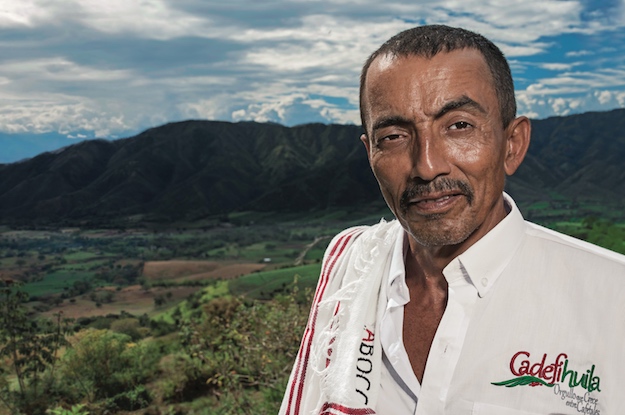This article is adapted from AQ’s print issue on peace and economic opportunity in Colombia | Leer en español
At a coffee fair held on an outdoor basketball court in the Colombian town of Algeciras in July, vendors were selling fertilizer and portable fumigators. American specialty coffee buyers conducted a tasting, sniffing and slurping their way through 60 varieties grown on the surrounding Andean slopes. There were seminars and speeches, a parade and a pig roast.
It was a prosaic scene. For many fair-goers the highlight was snapping souvenir selfies with a familiar figure: the mustachioed, straw-hatted Colombian coffee farmer known as Juan Valdez. The only suspense revolved around who would prevail in the weed-whacker competition and snatch first prize, an orange Husqvarna lawn trimmer.
But for the people of Algeciras, long a battleground between Marxist guerrillas and government troops in a war that finally ended last year, the event was more than a quaint weekend diversion. In fact, it was the first coffee fair they’d ever hosted. And it stood as dramatic evidence that their town of 20,000 finally may be emerging from a dark and violent chapter.
“We’ve come here because we have seen a 180-degree shift,” Roberto Vélez, general manager of the Colombian Coffee Growers Federation, who was making his first visit to the town, told a crowd of about 500 people. “Today, there are opportunities for the people of Algeciras to move forward.”
Whether Algeciras and hundreds of other war-ravaged areas do indeed make headway toward greater development, prosperity and security will almost certainly determine the fate of Colombia’s fledgling peace process.
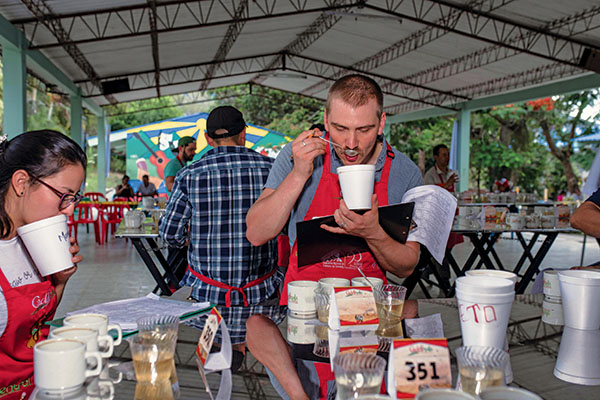 Coffee buyers test the product in Algeciras
Coffee buyers test the product in Algeciras
The peace treaty between the Bogotá government and the Revolutionary Armed Forces of Colombia, known as the FARC, ended a 52-year conflict that killed 220,000 people. The deal’s provisions for the rebels to surrender their weapons, and then enter traditional politics, have garnered the most international attention. But it also calls for the government to transform the countryside by carrying out land reform, investing in public works, and pursuing economic development in the same impoverished badlands that gave rise to the Marxist group back in the 1960s.
“These areas were abandoned. There was no state presence,” President Juan Manuel Santos, who was awarded the 2016 Nobel Peace Prize for negotiating an end to the war, said in a recent speech. “But we are going to correct that.”
Since the treaty was signed, the vast majority of the FARC’s 7,000 fighters have gathered in temporary camps, where they have disarmed while the group’s leaders launched a political party that plans to take part in legislative elections in 2018. De-mining teams are also hard at work in a country with the second-highest number of land mine victims after Afghanistan. So far they have cleared mines from 166 of the 763 communities where rebels had buried the explosives. In numerous towns, including Algeciras, rebel attacks, extortion and kidnappings are a thing of the past. A few tourists are even trickling in.
Still, political analysts, development experts and some government officials fret about the lethargic pace of progress overall. Instead of a Colombian Marshall Plan offering immediate relief, public works projects remain largely on the drawing board. In some areas abandoned by the FARC, the Colombian armed forces have been slow to plant the flag, which has allowed drug-trafficking gangs to move in. These groups are pushing peasant farmers to grow coca, the raw material for cocaine. Due to an expanding coca crop, the U.N. estimates that Colombia produced 866 metric tons of cocaine last year, an all-time high, up 147 percent from 2010.
Concerns about drugs and security have soured most private companies on investing in former rebel territory. President Santos leaves office in August and his successor could finally shift the government’s focus away from post-war rebuilding.
“These are the things that keep me up at night,” said a high-ranking government official involved in post-war rebuilding who requested anonymity.
“I don’t see the government doing anything,” lamented Adam Isacson of the Washington Office on Latin America, who recently visited several former conflict zones. “The ball has been dropped.”
A breath of peace
Like the first 100 days of a presidency, the initial months after the guns fall silent can set the tone and build momentum for national reconciliation and reconstruction. But the government may have dug itself a hole by creating outsized expectations for a rural renaissance. As a result, experts said, it needs to notch some early wins — a new bridge here, a farm-to-market road there — to create some forward progress and convince the skeptics.
Rafael Pardo, the government’s high commissioner for postwar reconstruction, preached the need for patience. A stone-faced former defense minister, Pardo was deeply involved in a successful effort in the late 1980s to disarm another Colombian rebel group known as the M-19.
That peace process required years to gel and so too, he said, will this one.
“We can’t do everything, everywhere, all at the same time,” Pardo told AQ from his office in the presidential palace. “This is a 15-year plan, not a 15-day plan.”
Pardo was one of several government officials to attend the Algeciras coffee fair. Many had never before ventured into the town, located in southwest Huila state 5,000 feet high in the Andes.
Until recently Algeciras was a no-go zone. The mountains provided ideal hiding places for FARC rebels, who pressured farmers to hand over food and secured cash by extorting small business owners. Town officials who refused to do the FARC’s bidding were forced to resign. A rebel-imposed curfew meant that anyone caught outside after dark could be shot.
Javier Rivera, 47, who grew up in Algeciras and is now the mayor, recalled, “I would go to bed knowing that around midnight there would be gunshots and machine-gun fire. And I would wonder: Which friend or neighbor of mine had just been killed?”
In 2000, the police station, the town hall and the only bank were reduced to rubble when the FARC attacked Algeciras with rockets fashioned out of cooking gas canisters. Coffee farmer Famith Buitrago pointed to his partially deaf right ear, the collateral damage from a grenade that exploded during a rebel attack in 2005.
“We were like pool balls getting hit from all sides,” he said. “Everyone in Algeciras has a similar story.”
That narrative has begun to shift.
A decade-long U.S.-backed military offensive weakened the FARC and drove its leaders to the bargaining table. Once peace talks were launched in Havana, Cuba, in 2012, security in Algeciras began to improve. In January, local FARC units withdrew to a nearby demobilization zone, where they handed in their AK-47s and pistols and signed up for job training and high school equivalency courses.
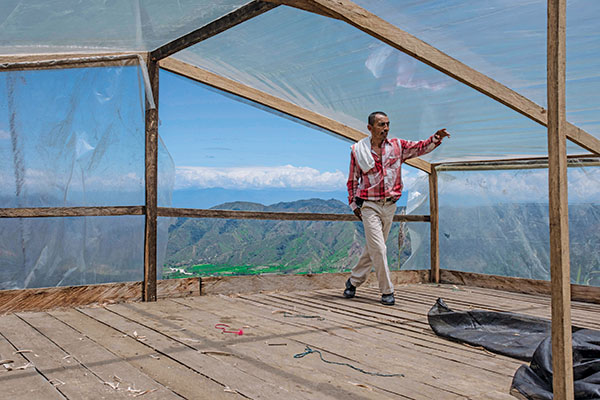 A newly built space for drying coffee beans in Algeciras
A newly built space for drying coffee beans in Algeciras
Now, land prices are inching up. Several banks have opened branches in Algeciras, and are lending more money. People who abandoned their farms are returning, while some of those who stayed put are planting more coffee and delving into new crops, like avocados. Among them is Buitrago, who has built two new wooden platforms to sun-dry his coffee and has replaced an old horse with an aerial cable system that now picks up sacks of coffee so they can be transported to Algeciras. “As the violence fades away, I have more incentive to invest in my farm and produce more,” he said. “This is progress.”
Best-laid plans
One farmer who is making large bet on the future is Neider Suazo. After his father was killed by the FARC in 1998, Suazo inherited his 20-acre coffee plantation but said it made little sense to increase production because the FARC would demand a bigger extortion payment. But since the peace treaty was signed, Suazo, with the help of relatives, has spent about $20,000 to build six fish ponds on the farm where, in addition to coffee, he now raises tilapia.
After tossing fish meal into the ponds, prompting swarms of pink tilapia to attack the pellets, Suazo said, “We are investing because we can now work in peace. We no longer have guerrillas coming around asking questions about what we’re up to.”
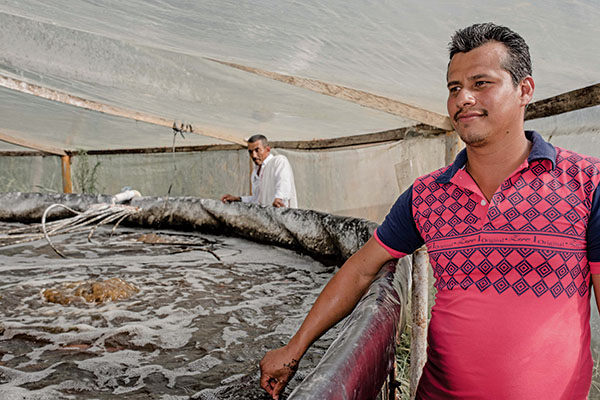 Suazo tends to his tilapia
Suazo tends to his tilapia
Such individual efforts stand as the main evidence of postwar progress in Colombia. But the Santos administration is promising a blitzkrieg of public works. Algeciras, for example, has been included in the government’s primary reconstruction program, called PDET. That’s a rather clunky Spanish acronym for Territorially Focused Development Program. But it aims high.
PDET is designed to help 7 million people living in 170 towns and villages where the government’s presence over the past half century has varied from scant to nonexistent. Over the next 15 years the government plans to spend about $38 billion — a massive sum for Colombia — on roads, schools, health clinics, aqueducts, Internet connections and power lines. It addition, peasants will be brought into Colombia’s social security system and have their properties legalized. Many peasants have lived on their land for years but lack titles that could be used as collateral for bank loans to help them upgrade their farms.
“It’s going to be a very intensive effort,” said Mariana Escobar, director of a new government body that oversees PDET.
Another program will target coca farmers. The FARC was deeply involved in the drug trade, and many coca plantations are located in former rebel territory. Now, drug farmers will be paid monthly stipends of $350 over the next year to uproot their coca and replace it with food crops, like pineapples and palm hearts. To help them get these products to market towns, the government, with help from the U.S. Agency for International Development, is designing access roads.
Departing U.S. Ambassador Kevin Whitaker, a high-profile supporter of the peace process, told AQ, “Building even a basic road in some of these areas can be transformative in opening up parts of the countryside to licit economic activities.”
But partly due to legal roadblocks and bureaucratic snafus, there are few signs of this rural metamorphosis.
Under the accord, reconstruction efforts in former war zones could not begin until the FARC rebels fully disarmed — which did not happen until August. But a bigger factor has been the innate slowness of government. Even in major cities like Bogotá and Medellín, public works can get sidetracked by agency infighting, budget shortfalls and corruption. These problems are magnified when the government tries to develop remote regions that have been ignored for generations, said Alex Fattal, a Penn State University professor and author of a forthcoming book about the FARC.
“There are filing cabinets filled with plans and projects. But the bureaucracy is crippling,” Fattal said. “This is the knot at the center of so many knots: the government’s inability to operate with any real agility.”
Risk of relapse
Good intentions are also getting in the way.
Across Colombia, towns, villages and indigenous communities are meeting to determine what infrastructure projects they will need under the PDET program. It’s a laudable shift away from top-down development, but grassroots decision-making can also be sluggish. All told, there will be some 11,000 meetings in the coming months. That means former conflict zones may not see workers pouring concrete, clearing the way for new roads, or stringing up power and Internet cables until well into 2018 — or beyond.
“We need to do some important investments this year,” said the government development official who spoke of sleepless nights because of construction’s slow pace. “That would send a message that this peace process is really happening.”
The persistent curse of coca has slowed progress as well. Some drug farmers are coming under pressure from traffickers to keep planting coca, while others fear that the government will renege on its promises of aid for replacing coca with food crops. Despite projections that coca farmers would voluntarily eradicate 125,000 acres this year, so far they have uprooted just 15,000 acres.
As a result, drug trafficking gangs continue to flourish. In addition, security forces must deal with a smaller rebel group, known as the ELN, and dissident FARC members who have rejected the peace accord and have gone back into the bush.
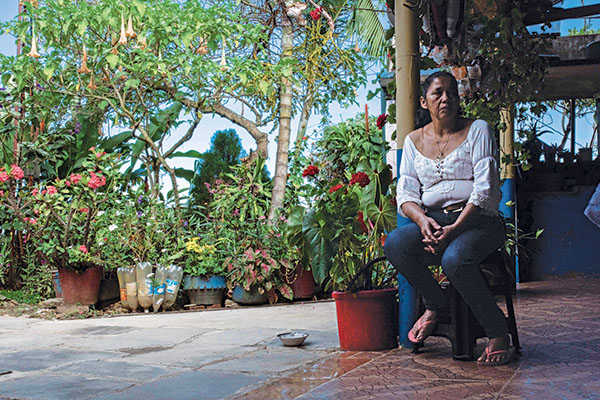 Residents of small towns like Algeciras wonder when the violence will end
Residents of small towns like Algeciras wonder when the violence will end
About 300 rearmed FARC fighters are now operating in southern Guaviare state. Just as in Algeciras, San José del Guaviare, the state’s capital, has seen some promising advances. Located 180 miles south of Bogotá where Colombia’s great plains give way to Amazon rain forest, the town has a nascent tourist industry thanks to spectacular rock formations, indigenous stone paintings, sport fishing, and excursions to see freshwater dolphins in the jungle rivers. There’s even an annual mountain bike race that runs through former FARC strongholds.
But all this is being threatened by the FARC holdouts. In May, the renegade group kidnapped a U.N. anti-drug official and held him for six weeks. It has also banned state workers from carrying out postwar rebuilding projects in at least three villages.
Javier Montoya, the manager of San Jose del Guaviare’s main beer distributor, said he receives phone calls every week from the dissidents demanding extortion payments. He has refused to open his wallet and has suffered the consequences. In April, a bomb partially destroyed his warehouse.
“I never thought this would happen during a peace process,” Montoya said.
Not surprisingly, the security problems have dampened private-sector interest despite a new law that would give businesses substantial tax breaks for investing in these trouble spots. Although low global oil prices are a factor, energy companies that are accustomed to operating in conflict zones have shown no interest yet in ramping up exploration in these areas, said Francisco Lloreda, director of the Colombian Petroleum Association.
The blueprint
Large companies that have moved in can be counted on one hand. They include Starbucks, which is advising growers on how to improve the quality of their coffee, and the Colombian dairy company Alquería, which is helping farmers increase milk production. In 2015, India’s Hero Motor Corp., the world’s largest motorcycle manufacturer, opened a factory in Villa Rica, a town that was targeted by FARC rebels just three years earlier in an attack that destroyed the police station and killed five civilians.
“There are definitely immediate business opportunities,” said Whitaker, the U.S. ambassador.
To encourage risk-takers, several venture capital funds are focusing on former Colombian war zones. They include Acumen, a New York-based nonprofit that is underwriting several small companies that purchase coffee and cocoa.
“If you don’t generate prosperity in these territories, if you don’t generate jobs and sources of legal income, then it’s going to be a lot harder for peace to take hold,” said Virgilio Barco, who directs Acumen’s Latin American operations. “But I think the situation is a lot better than it was before.”
That’s a recurring argument among government officials who insist that help will come … eventually.
“We are just getting started,” Pardo said. “It takes more than a few weeks to go from hell to heaven.”
It took four years of tense negotiations in Havana for the Colombian government to hammer out the peace deal with the FARC. All along experts were predicting that putting its provisions into place would be far more challenging. A year after Colombia’s historic peace treaty was signed, they appear to be right.


